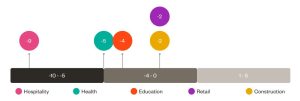6 Tips to increase employee engagement in the workplace
We surveyed over 6,000 Aussies and Kiwis and found that merely a quarter of employees (26%) feel a strong sense of engagement in their current positions.
This leaves a significant 74% of the workforce either disengaged (30%) or in a state of passive engagement (44%). But it also highlights a substantial opportunity for employers to revitalise their workforce’s enthusiasm and investment!
Net Engagement Score (NES) by industry, as reported in our 2023 Frontline Feel Good Index Report:
When calculated, the NES score can range anywhere between -100 and 100. Score above 0 is considered a good score.

NES across our industries
These results are a great benchmark and show there is room for employers to improve worker engagement across all industries.
Our best strategies to improve employee engagement:
“When people are financially invested, they want a return. When people are emotionally invested, they want to contribute.” — Simon Sinek
This leads us to two questions we must answer:
- “How can we foster a workforce that’s not just present, but truly invested?” and
- “How can we make them emotionally connected to their work?”
1. Highlight the impact they make in their role:
A staggering four in five highly engaged workers see their work as meaningful and producing positive impacts. The ability to recognise their work’s significance is pivotal in keeping people engaged. This resonates even more profoundly for those who are already highly engaged, with a quarter of them striving to feel proud of their accomplishments.
2. Don’t forget to congratulate:
Everyone wants to feel valued, and this is an aspect often overlooked. Regular recognition goes a long way in bolstering engagement. Acknowledging contributions, whether big or small, instills a sense of worth and motivates employees to maintain their exceptional performance.
3. Focus on quality professional development and training:
Highly engaged workers are nearly 3x more likely to believe their organisation adequately invests and is committed to their professional development. Making this investment into professional growth is one way people feel they are more than simply a worker but are a valued contributor to the bigger picture.
4. Foster a positive workplace culture:
Highly engaged workers are 20x more likely to actively promote their organisation. This underscores the significance of a shared value system between the employee and the organisation. A positive workplace culture transforms tasks from mundane duties to purpose-driven missions, nurturing enthusiasm and passion in accomplishing them.
5. Ensure employees feel secure in their role:
Highly engaged staff are 2.5x more likely to think their organisation is effective in retaining quality staff. Updating and diversifying your retention strategies tells employees they are not just secure, but also valued in their role. Try creating a personalised retention plan for each employee, as every person’s situation, priorities and needs are unique.
6. Hire with purpose:
Highly engaged workers are 2.2x more likely to believe their organisation effectively attracts quality staff. Transparent attraction strategies highlight the organisation’s commitment to recruiting talent that aligns with both skills and culture. Remember, each new addition to the team influences not just the business but the collective team spirit as well.
Employee engagement is essential.
Prioritising employee engagement is not just an option anymore—it’s a necessity. It’s up to employers to foster a culture where people not only excel in their role but also find fulfilment and purpose in their careers with the company.
To delve deeper into employee priorities and learn how you can maximise employee engagement for increased performance, download the full 2023 Frontline Feel Good Index Report.
Read more
